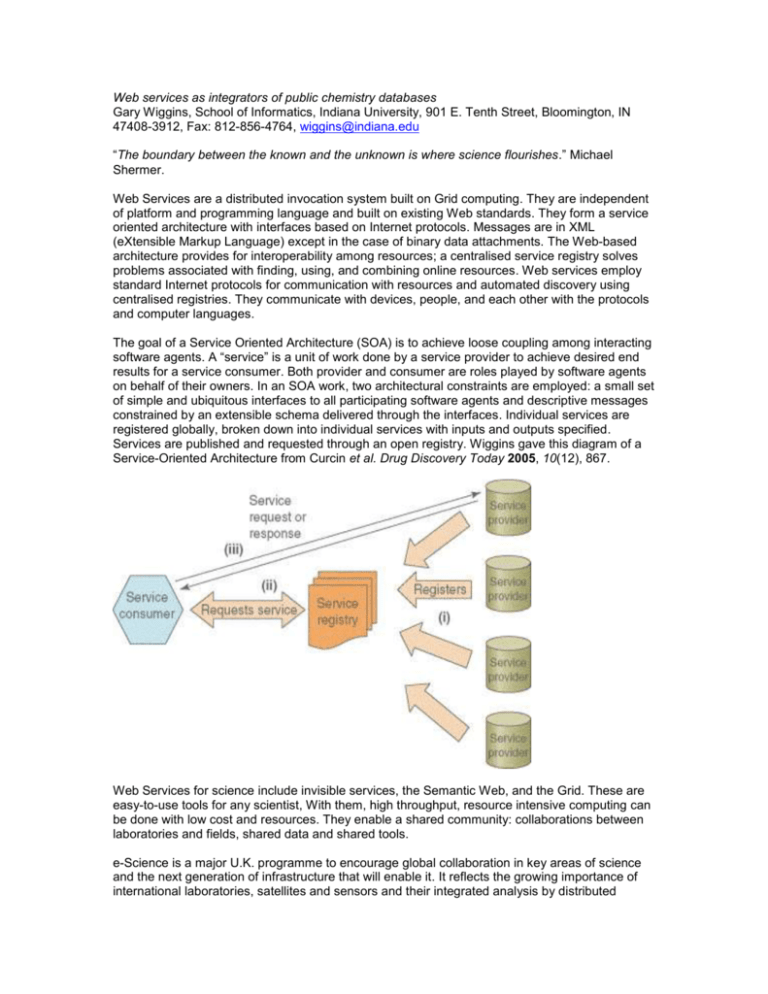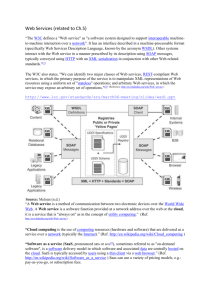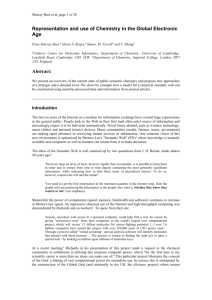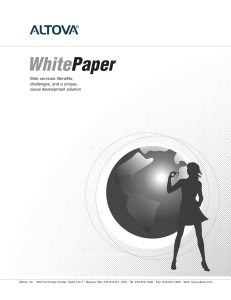CINF 33 Web services as integrators of public chemistry databases
advertisement

Web services as integrators of public chemistry databases Gary Wiggins, School of Informatics, Indiana University, 901 E. Tenth Street, Bloomington, IN 47408-3912, Fax: 812-856-4764, wiggins@indiana.edu “The boundary between the known and the unknown is where science flourishes.” Michael Shermer. Web Services are a distributed invocation system built on Grid computing. They are independent of platform and programming language and built on existing Web standards. They form a service oriented architecture with interfaces based on Internet protocols. Messages are in XML (eXtensible Markup Language) except in the case of binary data attachments. The Web-based architecture provides for interoperability among resources; a centralised service registry solves problems associated with finding, using, and combining online resources. Web services employ standard Internet protocols for communication with resources and automated discovery using centralised registries. They communicate with devices, people, and each other with the protocols and computer languages. The goal of a Service Oriented Architecture (SOA) is to achieve loose coupling among interacting software agents. A “service” is a unit of work done by a service provider to achieve desired end results for a service consumer. Both provider and consumer are roles played by software agents on behalf of their owners. In an SOA work, two architectural constraints are employed: a small set of simple and ubiquitous interfaces to all participating software agents and descriptive messages constrained by an extensible schema delivered through the interfaces. Individual services are registered globally, broken down into individual services with inputs and outputs specified. Services are published and requested through an open registry. Wiggins gave this diagram of a Service-Oriented Architecture from Curcin et al. Drug Discovery Today 2005, 10(12), 867. Web Services for science include invisible services, the Semantic Web, and the Grid. These are easy-to-use tools for any scientist, With them, high throughput, resource intensive computing can be done with low cost and resources. They enable a shared community: collaborations between laboratories and fields, shared data and shared tools. e-Science is a major U.K. programme to encourage global collaboration in key areas of science and the next generation of infrastructure that will enable it. It reflects the growing importance of international laboratories, satellites and sensors and their integrated analysis by distributed teams. The total investment is about £200 million over the five-year period from 2001 to 2006. CyberInfrastructure is the analogous U.S. initiative. Grid technology supports e-Science and CyberInfrastructure. Imaging instruments, computational resources, and large-scale databases can be accessed at the desktop allowing data acquisition, analysis and advanced visualisation. Wiggins produced a diagram of basic architectures: servlets/CGI (Common Gateway Interface) and Web Services. Browser Browser HTTP GET/POST Web Server WSDL WSDL Web Server JDBC DB or MPI Appl. GUI Client SOAP W S D L Web Server SOAP JDBC DB or MPI Appl. GUI = graphical user interface SOAP = Simple Object Access Protocol http://www.w3.org/TR/soap12-part1/ WSDL = Web Services Description Language JDBC = Java Database Connectivity, an application program interface (API) specification for connecting programs written in Java to the data in popular databases such as that from Oracle DB = database MPI = Message Passing Interface http://www-unix.mcs.anl.gov/mpi/standard.html Web Services are important because they enable the building of a true science community; they enable interoperability between tools and the integration of data; they change the way scientists work by achieving new levels of integration; and researchers spend less time coding, and have more time for science. Web Services can be used when applications do not have severe restrictions on reliability and speed; when two or more organisations need to co-operate (i.e., one needs to write an application that uses another’s service); services can be upgraded independently of clients; and services can be easily expressed with simple request/response semantics and simple state. Benefits of Web Services include the provision of a clean separation between a capability and its user interface; an increase in productivity and flexibility; and integration across multiple applications. Web Services have many advantages. The output is in human- and computer-readable formats; I/O (input/output) formats are based on standard Internet protocols; resources accessible serverto-server allow automated I/O; integration is based on specific services (the user selects the services or data needed without downloading the entire data set); description protocols provide details of the service provided and the interface components; Semantic Web standards increase efficiency; the services use a central registry and a standardised description of the services; and the quality and status of the information is dynamically available. There are, however some drawbacks. Web Services are based on new technologies and time and commitment are required to learn them. Standards are still in a state of rapid flux and there are issues with security, and privacy and the quality of data (and, for chemistry, the quantity of open data). Components of Web Services include protocols (SOAP, WSDL and Universal Description, Discovery, and Integration, UDDI); XML as a basis for the protocols; ontologies, such as OWL (Ontology Web Language); and the Semantic Web. The components of the Semantic Web for chemistry are: XML (eXtensible Markup Language); RDF (Resource Description Framework); RSS (Rich Site Summary); Dublin Core (which allows metadata-based newsfeeds); OWL (for ontologies); and BPEL4WS (Business Process Execution Language for Web Services, see Murray-Rust et al. Org. Biomol. Chem. 2004, 2, 3192-3203). SOAP is a flexible protocol to communicate information between a server and a server, or a client and a server, using XML. It supports Remote Procedure Calls (RPC) and allows layers (security, authentication, transactions) over the basic SOAP elements. WSDL describes a service’s interface to clients. The services register themselves with Web Services and WSDL describes how to contact and interact with those services (in terms of I/O operations and messages to aid interaction with the client). WSDL is an XML-based interface definition language, allowing users to define the APIs for all of their services in WSDL. WSDL documents are broken into five major parts: data definitions (in XML) for custom types; abstract message definitions (request, response); organisation of messages into “ports” and “operations” (classes and methods); protocol bindings (to SOAP, for example); and service point locations (URLs). A single WSDL document can describe several versions of an interface and can describe several related services. UDDI provides ways for clients and services to interact with other services. It uses XML and defines the means of access (e.g., URL or e-mail); defines the services hosted by an entity; uses business-oriented tags; and uses SOAP for communicating. XML allows definitions of types of documents. Tags are used to specify components of documents. XML allows specification of namespaces to differentiate between identical tag names, which do not provide semantics other than simple hierarchical relations. It is a language for building languages, with basic rules (to be well formed and be valid). Particular XML “dialects” are defined by XML schemas. XML itself is defined by its own schema. It is extensible via namespaces. It has many dialects unrelated to Web Services (RDF, SVG, GML, CML, XForms, XHTML). Many basic tools, such as parsers, and XPath and XQuery for searching and querying, are available. XML lends itself to distributed computing since it is just a data description and is platform and programming language independent. WSDL describes how to invoke a service and it can bind to SOAP and other protocols for actual invocation. SOAP wire protocol extension for conveying Remote Procedure Calls can be carried over Hypertext Transfer Protocol (HTTP) and Simple Mail Transfer Protocol (SMTP). OWL builds on RDF and RDFS (RDF Schema) and adds a means for richer descriptions of properties and classes, e.g., disjoint classes, cardinality of classes, and characteristics of relations, such as symmetry. There are three versions of OWL. OWL Lite is a classification hierarchy with simple constraints. OWL DL (OWL Description Logics) offers maximum expressiveness while retaining computational completeness (all conclusions are guaranteed to be computed) and decidability (all computations will finish in finite time). OWL Full has maximum expressiveness and the syntactic freedom of RDF with no computational guarantees. RDF is an alternative to UDDI but is said to be more flexible and extensible. It comprises a lightweight ontology system for knowledge exchange, a language for representing information about resources, and a standard for statements describing resources. RDF statements are triples consisting of a Subject (the resource being described), a Predicate (the property ascribed to the resource) and an Object (the entity to which the resource bears that property). RDF statements ascribe properties to resources but RDF provides no means for describing those properties. RDFS defines classes and properties that are used to describe classes, properties, and other resources. [Is that right?] RDFS vocabulary descriptions are written in RDF. RDFS is not a particular vocabulary of properties (e.g., “creator”) for a particular domain, rather, it provides a means of specifying such a vocabulary. Standards for Web Services include Business BPEL4WS, Ontology Web Language Semantics (OWL-S), and Web Service Modelling Ontology (WSMO). Standards setting boards include W3C (the World Wide Web Consortium), OASIS (Organisation for Advancement of Structured Information Standards, which works on ebXML, i.e., e-business XML, and UDDI) and the Global Grid Forum, a community of users, developers, and vendors leading the global standardisation effort for grid computing. W3C standardises OWL, RDF and RDFS, SOAP, URI/URL/URN (Universal Resource Identifier/Locator/Name), WSDL, and XML. The main objectives of Semantic Web-Enabled Web Services (SWWS) are to provide a comprehensive Web Service description framework, define a Web Service discovery framework, and provide a scalable Web Service mediation middleware. This is a programme of the European Commission to run from 2002-2005 (http://swws.semanticweb.org). Web Services integration projects in the biosciences include myGrid (http://www.mygrid.org.uk/), BIOPIPE (http://biopipe.org/) and BioMOBY (http://biomoby.org/). Web Services for chemistry face significant problems, e.g., performance and scalability, the wealth of proprietary data, and competition from high-performance desktop applications (see Geoff Hutchison’s “it’s a puzzle” blog, January 5, 2005). Other problems are lack of a substantial body of trustworthy Open Access databases and the fact that there is no standard chemical data format (over 40 are in regular use and require normalisation to one another). To supply the missing ingredients, chemical communities need to assemble Open Access databases, with well-defined quality assurance procedures performed by distributed peer-review systems, and the software underlying the databases needs to be open source. There are some chemistry databases on the Web: Marc Nicklaus lists 37 databases which have structure searching and at least 100 molecules, as of October 2001 (http://cactus.nci.nih.gov/ncidb2/chem_www.html) and SoaringBear lists 15 (http://geocities.com/soaringbear/biomed/chem.html). The NARSTO Quality Systems Science Center (http://cdiac.esd.ornl.gov/programs/NARSTO/) is an institutional repository for pollutant species in the troposphere over North America. It is part of the Carbon Dioxide Information Analysis Center at Oak Ridge National laboratory and operates with the NARSTO Data and Information Sharing Tool (http://mercury.ornl.gov/narsto/). Other public data repositories include the Developmental Therapeutics Program/National Cancer Institute database with structures for over 200,000 compounds and some assay data for downloading (http://dtp.nci.nih.gov/docs/dtp_search.html); ZINC (see Irwin’s paper in this report) and other screening databases; the NIST computational chemistry database; environmental fate and exposure databases; the ChemExper Chemical Directory with more than 200,000 substances and more than 10,000 IR spectra (http://chemexper.com/); HIC-Up, the HeteroCompound Identification Centre in Uppsala, with 5384 substances as of January 15, 2005 (http://xray.bmc.uu.se/hicup/); Chemicals with Pharmaceutical Activity; a structural database of 400 3D structures (http://www.chem.ox.ac.uk/mom/chemical-database/); cheminformatics.org with 41 data sets in nine categories as of August 18, 2005 (http://www.cheminformatics.org/); WebReactions (http://webreactions.net/); MolTable (http://www.moltable.org/); MatWeb Materials Property Data (http://www.matweb.com/index.asp?ckck=1); Spectral Database for Organic Compounds (SDBS) with over 32,000 compounds and EI-MS, FT-IR, 1H NMR, 13C NMR, Raman, and ESR spectra (http://www.aist.go.jp/RIODB/SDBS/cgi-bin/cre_index.cgi); and Christoph Steinbeck’s NMRShiftDB, with 14,753 structures as of August 19, 2005, featuring peer-reviewed submission of data sets (http://www.nmrshiftdb.org/). Christoph Steinbeck, commenting on the NMRShiftDB, on the chminf-l list on April 19, 2005 said “It is great to know that with PubChem there will be something like a single point of entry for people interested in structures and their properties. We are looking forward to link our datasets to PubChem structures”. Some other public repositories are what Wiggins calls “commercial teasers”: FTIRsearch.com from Thermo Electron, a demonstration file of 575 spectra from 87,000 in the full (commercial) database (https://ftirsearch.com/default3.htm); ChemACX, with catalogue data from 30 out of more than 350 suppliers (http://chemacx.cambridgesoft.com/chemacx/index.asp); and Sunset Molecular Discovery’s Wombat (World of Molecular BioAcTivity), with 117,007 entries with over 230,000 biological activities, Wombat PK, a database for clinical pharmacokinetics, containing 643 substances with 4668 measurements, and three sample files from Wombat containing 341 Histamine-1 receptor antagonists (http://www.sunsetmolecular.com/). BlueObelisk.org is a group of chemists, programmers, and informatics specialists working collaboratively on projects such as: Chemistry Development Kit (CDK), JChemPaint, Jmol, JUMBO, NMRShiftDB, Octet, Open Babel, QSAR, and the World Wide Molecular Matrix (WWMM). Existing projects at Indiana University include System for the Integration of Bioinformatics Services (SIBIOS, http://sibios.engr.iupui.edu), PlatCom: A Platform for Computational Comparative Genomics (http://bio.informatics.indiana.edu/sunkim/Platcom/) and Reciprocal Net (http://www.reciprocalnet.org/index.html). The university also plans design of a Grid-based distributed data architecture, development of tools for high throughput screening (HTS) data analysis and virtual screening, a database for quantum mechanical simulation data, and chemical prototype projects, including novel routes to enzymatic reaction mechanisms, mechanism-based drug design, and data enquiry based development of new methods in natural product synthesis. Wiggins showed the home pages of the Community Grids Lab (http://communitygrids.iu.edu) and the Open Systems Lab (http://osl.iu.edu). The future of Web Services depends on adoption of standards; incorporation of Web Services in current and newly developed applications; tackling security, privacy, and quality of data issues; and the development of Web Services tools and resources for e-Science. Tripos, for example, has embraced Web Services. The company’s Service-Oriented Informatics (SOI) solutions aim to make it easier to incorporate Tripos’ high-throughput workflows and Tripos, in partnership with SciTegic, will use Web services ensure software compatibility between the two companies’ products. Peter Murray-Rust has published a provocative thought: “While much bioscience is published with the knowledge that machines will be expected to understand at least part of it, almost all chemistry is published purely for humans to read” (Murray-Rust et al. Org. Biomol. Chem. 2004, 2, 3201). Wiggins concluded with another quotation: “The future of chemistry depends on the automated analysis of chemical knowledge, combining disparate data sources in a single resource, such as the World-Wide Molecular Matrix, which can be analysed using computational techniques to assess and build on these data.” (Townsend et al. Org. Biomol. Chem. 2004, 2, 3299). Bibliography Coles, Simon J.; Day, Nick E.; Murray-Rust, Peter; Rzepa, Henry S.; Zhang, Yong. “Enhancement of the chemical semantic web through InChIfication.” Organic & Biomolecular Chemistry 2005, 3, 1832-1834. Curcin, Vera; Ghanem, Moustafa; Guo, Yike. "Web services in the life sciences." Drug Discovery Today 2005, 10(12), 865-871. Day, Michael. Metadata: Mapping between metadata formats. http://www.ukoln.ac.uk/metadata/interoperability/ (accessed 8/6/2005) De Roure, D.; Jennings, N. R.; Shadbolt, N. R. “The Semantic Grid: Past, present and future.” Proceedings of the IEEE 2005, 93(3), 669-681. Jensen, Michael; Patrick, Timothy B.; Mitchell, Joyce A. “Web services for bioinformatics.” PSB 2004 Tutorial Murray-Rust, Peter S.; Mitchell, John B.O.; Rzepa, Henry S. “Communication and re-use of chemical information in bioscience.” BMC Bioinformatics 2005, 6, 180. Murray-Rust, Peter; Mitchell, John B.O.; Rzepa, Henry S. “Chemistry in bioinformatics.” BMC Bioinformatics 2005, 6, 141-144. Murray-Rust, Peter; Rzepa, Henry S.; Tyrrell, Simon M.; Zhang, Yong. “Representation and use of chemistry in the global electronic age.” Organic & Biomolecular Chemistry 2004, 2, 3192-3203. Salamone, Salvatore. “Tripos embraces Web Services. Bio-IT World, 2005, 4(8), 8. Shermer, Michael. “Rumsfeld’s Wisdom.” Scientific American 2005, 293(3), 38. Townsend, Joe A.; Adams, Sam E.; Waudby, Christopher A.; de Souza, Vanessa K.; Goodman, Jonathan M; Murray-Rust, Peter. “Chemical documents: machine understanding and automated information extraction.” Organic & Biomolecular Chemistry 2004, 2, 3294-3300. World Wide Molecular Matrix. http://wwmm.ch.cam.ac.uk/wwmm.html Summary Report – W3C Workshop on Semantic Web for Life Sciences, October 27-28, 2004. http://www.w3.org/2004/10/swls-workshop-report.html






